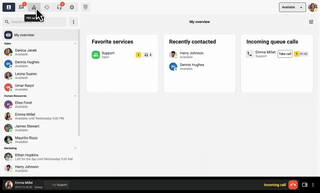A telephone exchange is as useful for large worldwide organizations as it is for one-man businesses. Because who answers the call can make or break your business. It conveys a serious image of the company and is a smart way to both streamline operations and save money.
The switchboard – from desktop and clunky to cloud-based and user-friendly
A telephone switchboard, also known as a subscriber switchboard, company switchboard or PBX (Private Branch Exchange), is an organization’s private communications network that allows callers to switch between different menu options and select extensions. The PBX allows employees to communicate with each other via their own network and receive calls from outside via the public switched telephone network (PSTN) on an integrated services digital network (ISDN) protocol.
Three types of telephone exchanges
Telephone exchanges can be divided into three main categories: analog, digital and cloud-based. Today, the cloud-based switch is by far the most popular, but there are still many companies using the other variants.
Whatever type of switchboard you choose, it’s all about strengthening internal and external communication with your customers by, for example, connecting callers to the right department or person or setting up an IVR to announce your opening hours. A telephone exchange or switchboard system handles and connects calls, allowing you to offer multiple phone lines connected to the public landline network or a VoIP network.
1. the analog, traditional telephone exchange
The first telephone exchanges were a further development and an automated version of the manual exchanges, where all call forwarding was handled by an operator. The switchboard brought together a number of external extensions into a single internal line, from which they could then be transferred to employees – without everyone in the company needing their own external extension. With a company switchboard, it was possible for more people to have access to the limited number of external extensions, at a lower cost. Getting the most out of a limited number of external extensions, at the lowest possible cost, was the original purpose of the telephone exchange.
The analog switchboard requires a physical server to be installed on site and all connected phones to have fixed lines. These are complicated installations that involve a large initial investment. Many companies are still using older, failing PBXs because they were so expensive to buy that they put off replacing them. They are also expensive to maintain and require specialized skills to administer and make changes to the switchboard. If you have an older switchboard, it may be worth reviewing it as it may cost more than you think. Physical switches are also vulnerable, as it is more difficult to create redundancy with an old system.
Fixed telephone exchanges are less common today as the alternatives are more cost-effective, have more features and do not require the same physical space. In addition, we are moving more and more towards the cloud and more people are stopping using landlines completely, which means that the fixed telephone exchange is not as future-proof a solution as a cloud exchange.
2. the digital hybrid switchboard using SIP trunks
The traditional telephone network(PSTN) is based on copper wires from a local telephone company to different buildings and works by connecting telephones via sockets to the fixed telephone network. The PSTN is stable, but has not changed much over the years. As a result, a number of new technologies have emerged in line with increased digitalization. New channels have had to be integrated into the switches, and the internet has made newer communications possible. The first to emerge were VoIP switches and hosted switching systems, which offered greater flexibility and significantly lower costs than the old variants.
A digital switchboard or so-called hybrid switchboard is a combination of analog and digital VoIP technology. It uses SIP trunking technology. This means that you convert your fixed telephone exchange into a cloud-based system. This allows you to access more features and reduce your telephony costs. You can add more phone lines without having to install more cabling (which you have to do with a fixed telephone exchange).
3. The modern cloud-based telephone exchange
The most modern and popular option today is a cloud PBX, also called virtual PBX or IP PBX. A cloud PBX allows you to manage everything online in a browser, app or softphone. Your company can work more flexibly as you can access everything in the cloud instead of having to go through a physical server. This means you can easily work remotely as long as you have an internet connection.
A cloud PBX is scalable, it’s quick to get up and running, and no in-house maintenance is required – it’s included in the monthly cost you pay. Plus, you can easily integrate your cloud PBX with your CRM system and other features. Find out more about what a cloud PBX is and its benefits.
Why even small businesses need a switchboard
If you run a small business, you may think that a telephone exchange is pointless. After all, it’s worked well so far with just the mobile number. But if you want to aim higher and give your business a more serious image, you need a telephone exchange.
Not only do you send out positive signals to your customers, making you look like a bigger company, but it’s also much easier to handle the calls that come in. If you’re busy, simply record a message and play it back, or you can transfer the call to a colleague. This way you always make sure that those who want to reach you get help.
Customer experience is enhanced with a PBX and you can work more productively – even when you’re away on business. All modern PBXs today are cloud-based and built to handle mobile-only businesses. It’s not only an agile but also a cost-effective solution. Find out more about how to choose the right provider for your small business.
To sum up
As long as telephony has been an integral part of our working lives, the sheer volume of incoming and outgoing calls has posed a challenge for businesses. Because a missed call can be costly. Depending on the industry you work in, the consequences of a missed call can be more or less fatal. But whether your business receives emergency calls, or you sell cars, you don’t want to risk missing that important call because the line happened to be busy.
Businesses of all sizes, from sole traders to companies with thousands of users in different countries, need a telephone exchange. The best solution is usually to invest in a PBX service that is part of a larger, complete communications platform with all the features your business needs. It brings together telephony, business switchboard, contact center, integrations and video calling – all in one app. A complete solution for communicating with colleagues and customers, seamlessly gathered in one platform – and on one invoice.


